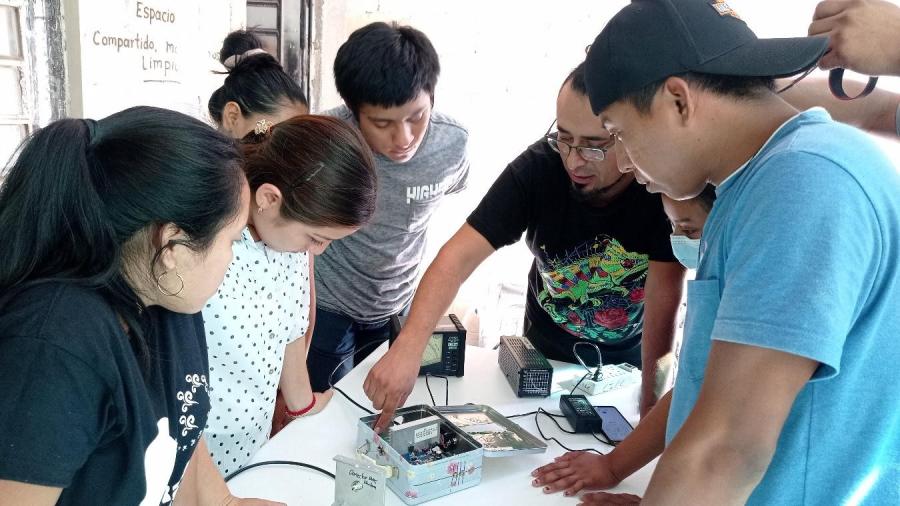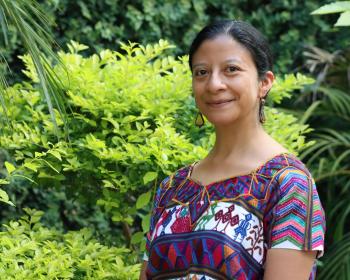Saraxoch
Last year, the road crew working about a mile outside Saraxoch told us the inhabitants there were guerrillas; that the army kept them under tight control because, fooled into taking up arms, they had killed a lot of people; who knew how many? they added. The civil patrol stationed at the entrance to the village would not let us past the pole hung across the road to block the entrance, except to those with permission from the military.
This year, we got in to see the villagers, just before 6 p.m., when they gather to perform the "civic act". They do it at 6 a.m., too. When it's pouring rain, they're excused. This September day it was half raining; of the 150 resident families, only about 100 people came.
The acto took about 20 minutes. During the acto, they pledged to the flag; sang the national anthem, the hymn to the Guatemalan soldier, the hymn to the civil patrol; all with straight backs, eyes forward, arms in salute at their hearts, except for the women with small babies in their arms. Mostly Spanish; some Kekchi. They responded with crisp shouts when the leader standing before the group denounced publicly the errors they had made taking up arms against their mother Guatemala. He reminded them, too, of the suffering that came upon them while they endured in the mountains, without shelter, food or clothing - life away from their own villages. Villages that are no more. Two to three years on the run, fearing attack, during which the weakest had died.
They responded with quickness and precision to commands to step in formation. They did it well - in strong voices and in unison. Perhaps they do it that way for visitors; or maybe it's the effectiveness of their re-education. A year and a half in New Acamal and another year and a half here in Saraxoch, where people from five different aldeas were sent to set up housing once they were judged adequately "re-educated." The sign at the entrance to Saraxoch reads "Antisubversive Village, Ideologically New. About a third of the villagers are under 12.
Chituj
The same was true in Chituj, 10 days later; the same 6 p.m. ceremony; another 85 families, the half of the population that remained after 15 months in the mountains eating mostly roots. This afternoon it was really raining, so they gathered in the hut that served as a communal meeting place. It also housed the marimba, which they carefully buried in 1982 when they fled to the mountains to escape army reprisals after guerrillas had killed the military commissioner and auxiliary mayors in the area.
In June 1983, they turned themselves in under amnesty. Ten months in camps near the army base in Coban with several thousand others; then two years in Acamal. This past February they returned to live as a separate community, with a blockaded entrance and armed civil patrol guards, as in Saraxoch. They shouldn't have let us in; but they did. They hadn't yet had a crop, and they were out of corn. But they were out of Acamal, and that was good. And next year would be better. They talked about building a school.
Acamal
In Acamal, this year as last, armed village men guarded the two ends of the camp and the path toward the mountains. When we arrived, four more were surrounding the small plaza while the army civilian affairs officer lectured a dozen men sitting in the hot noonday sun. They were left there for more than an hour while we completed our visit to the site, distracting their "re-educator". We were told that they were waiting for the agricultural technician to come and meet with them. But, he never came.
One armed guard, a fellow villager, moved with us on our tour, rifle in hand. With his wife and three children, he had been brought in by the army after four years in the mountains of Chisec. Two other children had died there. He spoke only enough to give us terse answers to our questions. It seemed he knew little Spanish. There were 63 in the group altogether. As we moved about, we met others of them. A couple dozen people, mostly women and children, were sitting inside the three-room, cement block central building which last year had been the office. Now, the place was empty except for the people, some extra pieces of clothes, a plastic jug or tin can here and there, and the straw mats they put on the floor to sleep on at night. There were empty hours in the village, but these "new" arrivals were not yet eligible to occupy them.
In one of the rooms, there were four women and about 10 children. Several of the kids had what looked like cold sores all over their faces and arms. So did our guide. One little one was old enough to sit up securely, but couldn't have weighed 12 pounds. I asked how old she was and the mother broke into a stream of conversation - perhaps Kekchi or Pocomchi - which I couldn't understand. I asked if the doctor (we had seen one when we first arrived) had seen the baby. I continued not to understand her words, but her actions were clear. She found a piece of clothing to cover the baby and followed me toward the door, followed by the other mothers and their children. Had the doctor seen the baby? I asked the guard. He looked away.
When we were in Acamal last year, there were more than 600 people, including the families who have since been moved to Chituj. This year, only about 200 people remained. Besides the people we saw in the central building, most of the 30 or so houses on the hillsides looked occupied. The sheds in which 26 families spent two years had been torn down.
This year the orphans were gone from the houses where they were cared for by a couple of teenage girls, themselves orphans. Last year, the officer said they were hoping that their parents would be found. Maybe they were. One teenage boy walked with me for a while. He had been in Acamal for three years. He didn't know where his family was or when he would leave.
There were changes in Acamal; but last year's questions only hardened. Why these re-education camps? Why these people? Farther north in the same department, in the aldeas around Chisec, the control was not so severe. Was it because of the fame of the Kekchi as "impenetrable and fierce"? The Spanish had not conquered them. The ladinos and Germans who later moved into the area had to learn Kekchi, so the story goes. But surely there were thousands more Kekchis (and Pocoms and Pocomchis, the other language groups in the area and in the re-education camps) who were as involved as these people with the guerrillas. The army has estimated that nationwide a quarter of a million Indians actively supported the guerrillas; tens of thousands of them must have been from this part of the country. Why these 1,500 people - more than two-thirds of them women and children?
Without even the charade of some legal process, these are military camps - militarily controlled populations. Local mayors and even the governor in the area admit that they have no jurisdiction; not even now with a civilian in the presidency. These camps are an expression of the fascism and racism characteristic of power groups in Guatemala, epitomized in its military, and inflicted on the indigenous population.
Since 1978 and peaking in 1982-83 militarization has consisted of the implementation of one euphemistically named program after another - Victory, Firmness, Institutional Consolidation, civil patrols, model villages, development poles, democratization. The costs, summed up most succinctly by the report of the Juvenile Section of the Supreme Court, is 100,000 orphans (many believe the real figures are much higher) most of whom are Indian children.
Amid all the devastation, militarization and attempts at ideologization and control, one cannot help but wonder how the children will fare. Prospects are not bright when one looks at the deteriorating economic picture. And it is too early to tell whether the brutal extremes or recent years will continue, or whether, perhaps, as is being proclaimed by the government, a corner is being turned in Guatemalan history.
But one thing is clear: the lives of the Guatemalan Indians have been touched with unprecedented depth. They have been relocated, re-educated, tortured and killed in frightening numbers. Their ethnic and cultural identity - seen as a threat to the centralized power structure - has been especially targeted for destruction. Yet, even with the many things which divide them, the probability that the Guatemalan Indians will find new, more effective forms of ethnically transcendent organization and cultural assertiveness (not without economic and political dimensions) has increased. As has the knowledge of the costs of being unprepared against those who would, so readily, kill or imprison them.
Article copyright Cultural Survival, Inc.


